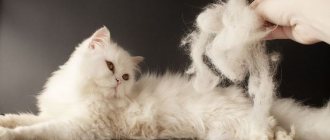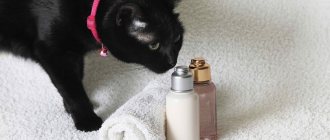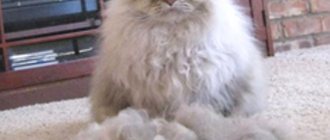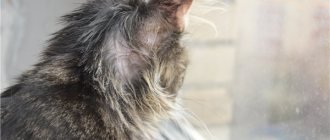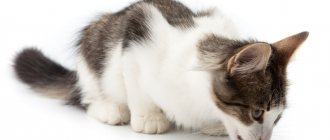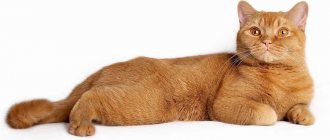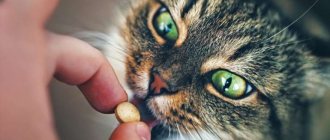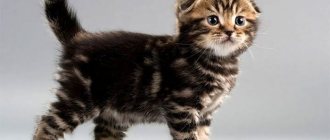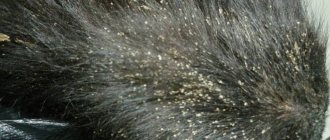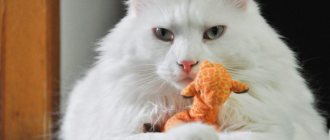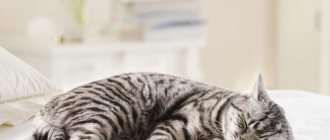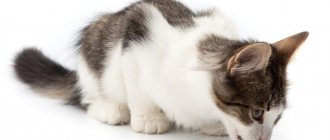The great variety of cat colors is determined by just two pigments: black (eumelanin) and red (pheomelanin). Coat color is the end point in the formation, movement and development of the cells (melanocytes) that produce these pigments. And the entire rich palette of colors appeared thanks to mutations that provoke deviations at different stages of this rather complex process.
Only one mutation poses some danger to the life of the animal, when melanocytes freeze in development at an early stage, and the hair is not painted. White coat color is not a color, but its absence. In addition, the cat becomes deaf, since the mutant gene affects the development of the hearing system. A white cat with two blue eyes is often deaf in both ears.
Color changes occur throughout the cat's life and do not cause the animal any problems. Depending on environmental conditions, the color of the coat may also change: in most cases this will not harm the cat’s health.
Why and how cats shed
Shedding in cats is a natural, regular process of changing coat. Shedding in animals happens for different reasons and at different times.
Shedding is a common occurrence in cats.
Seasonal
In a normal situation, a cat sheds twice a year:
- the beginning of cold weather. The transition to the winter season is signaled by a decrease in daylight hours, a decrease in temperature, and this turns on protective mechanisms in animals. Cats quickly grow new fur to keep them warmer in cold weather.
- onset of heat. In summer, the hair grows lighter so that it does not get hot.
Cats who roam freely react the most to the change of season. Their body senses weather changes more strongly and reacts more sensitively.
Pets that are not allowed outside also shed, but regardless of natural conditions. Shedding occurs once or twice a year.
Seasonal molting lasts about a couple of weeks to two months. If the shedding continues, you should contact your veterinarian.
According to breed characteristics
In cats with long, thick fur, this process occurs much more noticeably.
Mustaches are divided into 4 types:
- long-haired;
- semi-longhaired;
- short-haired;
- hairless.
The shorter the coat and thinner the undercoat, the less problems with shedding.
Techniques to improve pigmentation
The struggle for the ideal coat color is mainly faced by those who exhibit their young pets for the purpose of participating in breeding. Special shampoos and conditioners have been developed for each color to enhance the natural color of the coat. This type of washing is especially important for white cats, which should not have even a hint of yellowness.
For white and black individuals, special coloring powders are used before the exhibition. They can be dry or liquid. For especially problem areas in white cats (chin, tear ducts), gels with a whitening effect have been developed:
- All Systems;
- Super whitening gel.
Tinting is a harmless trick by breeders, giving an effect for no more than a day. To correct color for a long time, special nutritional supplements are used.
Suitable for red fur:
- complex Beaphar Algolit with seaweed (Beaphar Algolit Vitamin&mineral food supplement);
- GAC-carotene – granules from pure carrots containing carotene – provitamin A.
For darker colors, Seealgenmehl powder is recommended.
When do kittens start moulting?
Little kittens hardly shed; instead of fur they have baby fluff.
But caring for the fur of kittens should begin at a young age, as it will be much easier to accustom them to brushing.
However, caring for a kitten’s fur coat, and, in particular, brushing, must begin from an early age. It is much easier to train a small kitten to be groomed than an adult. Also, early brushing will help prepare them for their first shed.
It's easier to train a kitten to brush
Kittens begin to shed at about six months (5 – 8 months). Not only the fur changes, but also its color. When cats begin to shed for the first time, which can be up to 6 months, it is the most intense because the body is subject to a complex maturation process.
Age-related changes
Another inevitable reason why a cat's fur color has changed is age. And not only very old age, but also 5 years and even 3 years. The color usually darkens with age.
The multi-colored patterned colors gradually blur and turn into mush. The matter is complicated by ticking - coloring each hair with several transverse rings of light and dark tones. It should be noted that the patterned color cannot appear without ticking: these characteristics are genetically related.
Causes of severe shedding
The normal state of health of an animal during molting is if:
- Skin of normal color.
- The wool does not fall out in clumps, leaving no bald spots.
- The cat has a normal appetite and a healthy appearance.
- There is no unpleasant odor from the mouth or ears.
- body temperature is normal.
Hair loss is almost never the only symptom of any disease.
But sometimes the shedding becomes very strong.
Apartment molt
This type of shedding is common in pets. It is especially aggravated during the heating season, when the air in the apartment becomes very dry. You can use a humidifier to avoid excessive hair loss.
Apartment shedding is stronger during the heating season
Hormones
Unneutered cats who are not sexually active may suffer from hormonal imbalances. This greatly affects the condition of the pet’s skin.
Hormones can fluctuate after estrus, during pregnancy and after childbirth, just like in humans.
If you do not breed cats, then it is better to have surgery. If this is not possible, your doctor may recommend a course to avoid hormonal imbalances.
Stress
Cats have a very good nervous system. But even they are susceptible to stress under certain conditions:
- Change of habitual habitat.
- A trip in public transport, a long road.
- The appearance of a new animal in the house.
- Long-term loneliness.
- Change of habitual way of life (usually lack of affection, new prohibitions, etc.)
Cats shed a lot due to stress
Try to save your cat from unnecessary worries and isolate him from unusual situations. If the shedding goes away, then the problem is definitely due to stress.
Improper care and feeding
Owners should take very good care of their beloved pets. Feeding and care are the main things we need to provide them with. Care products must be strictly individual and suitable for the cat’s breed (shampoos, brushes, ointments).
The diet must be balanced; you cannot feed cats food from the table. Good animal feed contains all the necessary microelements and substances.
Hair loss also occurs due to dysbiosis after treatment with antibiotics. Intestinal function is disrupted.
Old age
As cats age, their body begins to work worse, their immune system weakens, causing their fur to become thin, dull, and fall out. This is a natural life cycle.
Cats lose fur as they age
Allergy
An allergy is a skin reaction, namely inflammation, redness, itching. This ailment occurs as a result of a change in the usual diet.
Allergies are usually accompanied not just by hair loss, but by the formation of bald patches.
In case of allergies, hair falls out due to damage to the skin.
A possible allergen should be excluded and the process of hair loss should be monitored.
Diseases and parasites
Severe hair loss is caused by a number of diseases, both skin and internal. This is already a pathology.
Skin diseases:
- Ringworm, fungal infections.
- Demodicosis (subcutaneous mites);
- Dermatitis (due to flea secretions, ectoparasites).
- Scabies (Notoedris cati mite).
- Eczema.
In case of allergies, hair falls out due to damage to the skin.
All of these diseases are characterized by clear lesions and are accompanied by irritation and fur loss.
Internal diseases include endocrine system disorders, including diabetes mellitus or neoplasms. In these cases, baldness is a secondary symptom and the primary cause must be dealt with.
Ways to reduce shedding
It is impossible to get rid of natural shedding. Only serious illnesses require drastic interventions. And in normal times, we can only slightly reduce hair loss.
Vitamin complexes
Supplements reduce the amount of hair loss. Be sure to consult with your veterinarian about which vitamins are right for your pet.
Vitamins help against hair loss
Along with the supplements, you can give yolk (if you are not allergic) and sprouted grass.
Sprouted grass is useful in combination with vitamins
Buy a special paste for removing hairballs from the body of cats.
Special feed
A balanced diet is very important during such a period.
To ensure that the fur is always beautiful and healthy, and molting is not a severe torment, the animal’s food must contain: biotin (vitamin B7, deficiency leads to inflammation in the hair follicles. Acute biotin deficiency can lead to baldness) taurine, sulfur (enhances the effect of biotin ), vitamins B6, B2, B5, iodine, calcium, phosphorus, omega-3, omega-6.
Cat food is rich in essential nutrients
If the cat's diet consists of regular foods, then biotin and vitamin B6 must be present, which are found in beef, pork, chicken yolk, salmon, poultry, cheese, carrots, and buckwheat. But keep in mind that cats may be allergic to “human” food.
Dry food must be of high quality, at least super premium. They have everything you need to feed your pet.
There are two types of food recommended for consumption during shedding:
- Food for healthy skin and coat.
- Food for removing hair from the stomach.
Bathing and brushing
During washing and combing immediately after bathing, a very large amount of dead hair is removed.
More fur is combed after bathing
For cats with short fur, it is enough to brush them a couple of times a week with a regular comb. For fluffy, long-haired breeds, you will most likely have to take a Furminator. This is a professional device with very fine teeth.
Cats with long and thick hair are best combed with a furminator.
Functions of the coat
Different hairs on cats have different functions. Topcoat hair covers the undercoat and skin. The sebaceous glands approach their base. Their secret prevents the wool from getting wet. In some breeds, the wool has a very high water-repellent effect, in others this ability is lower.
Downy hair forms a thermoregulating layer - it prevents the body from cooling down and overheating. The underpad also protects the surface of the skin from cracking, drying out, and damage. Wild cats, forced to wade through bushes for prey, have a denser undercoat. Through it, thorns and twigs cannot reach the delicate skin of the animal.
In addition, the pigment in the fur with a “wild” color allows the animal to merge with the surrounding landscape. Anyone who decides to get a pet that does not cause problems with shedding - hairless cats - is faced with the problem of caring for the pet's sensitive and delicate skin.
Hair also includes vibrissae - hard, long hairs located on the pads on the sides of the nose, above the eyes, on the lower jaw, and the back of the paws. Their length varies from 6 to 8-9 cm. Vibrissae are organs of mechanical sensitivity (tactile function).
A cat, having lost its fur coat along with whiskers and sensitive hairs on the body, loses confidence in movement. These hairs help determine the distance to objects, their temperature, atmospheric pressure and maintain the position of the body in space. It’s not for nothing that when a cat falls, it turns over so that it lands on its paws.
E. Filippova’s book “From a Cat’s Point of View” describes a case when a cat that fell into the tar had to be completely shaved. The poor thing was afraid to move actively until a new coat grew. Long sensitive hairs help plan a jump - they determine the speed and direction of air movement.
The hair density varies in different parts of the cat's body. For example, to protect the most delicate and vulnerable part of the cat’s body, nature has created a denser covering. There are more than 200 hairs per 1 mm2 of a cat's belly. There are slightly fewer of them on the back of the animal.
Each hair has its own muscle fibers. With any danger, temperature change, or excitement, the fibers contract and the coat rises. The matted fur of a cat during a fight or attack by an enemy increases the size of the cat's body, which should scare off the enemy. When the ambient temperature drops, the cat fluffs up its coat to increase the air “cushion”, which reduces heat loss.
Why is it important to remove dead hair?
Villi that have already fallen out but are not removed from the cat’s body can cause irritation and itching on the animal’s skin. It actively licks off excess fur and tries to remove it with its paws.
This can be dangerous because when hairballs get into the stomach, gastrointestinal upset and intestinal obstruction begin.
Hair getting into the stomach leads to intestinal disorders and causes nausea
With its paws, a cat can scratch itself, which serves as a breeding ground for infections that cause skin diseases.
Wool flying around the house can cause allergies in allergy sufferers living in the house, especially in the spring.
Hypopigmentation (lightening)
There are several genetic diseases in cats that result in a lack of pigment in the hair and skin. They are quite rare and cannot be treated:
- Persian cats have a bluish-smoky color with yellow eyes and have Chediak-Higashi syndrome. This disease causes not only discoloration of the coat, but also partial albinism of the eyes, photophobia and cataracts.
- Siamese cats (more often females) have vitiligo. In young animals, progressive patchy depigmentation of the nose, lips, eyelids, paw pads, and perianal area is observed. Although these cats cannot be used for breeding, vitiligo does not prevent pets from leading full lives.
Acquired lack of pigment can occur under the influence of any factors that destroy melanocytes:
- injuries;
- burns;
- frostbite;
- bacterial or fungal skin infection;
- use of certain medications (glucocorticoids).
Dangerous cancers - lymphoma, squamous cell carcinoma - can look similar to vitiligo.
